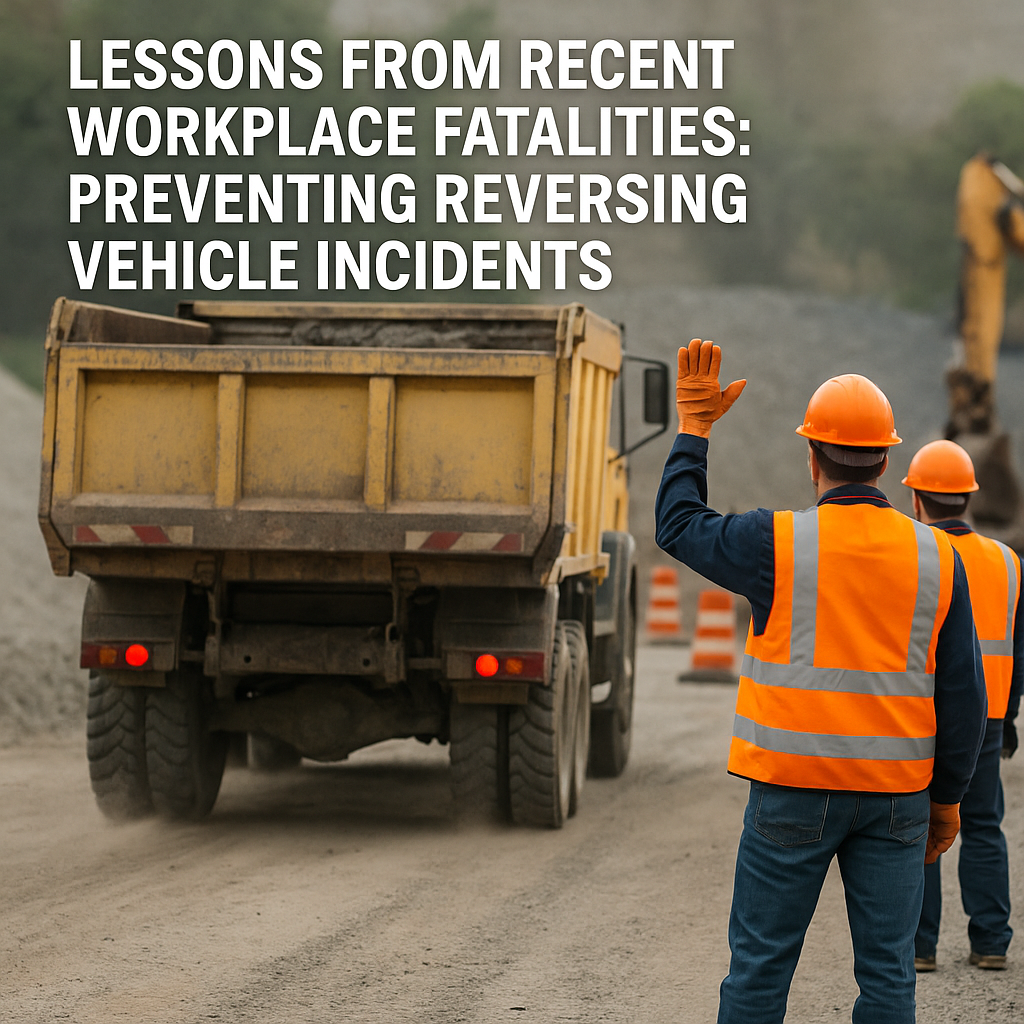Lessons from Recent Workplace Fatalities: Preventing Reversing Vehicle Incidents begins with a hard truth—lives are still being lost to preventable vehicle-related accidents at job sites across Canada.
As industries move faster with tight deadlines and complex logistics, reversing vehicles have become an overlooked but deadly hazard.

In August 2025, multiple fatal incidents, including a worker struck by a reversing dump truck in Ottawa, have sparked national concern. These tragedies underscore an urgent call for stronger protocols, better training, and renewed focus on high-risk vehicle movement.
This article explores these lessons and provides actionable strategies to prevent reversing vehicle incidents before they happen.
Lessons from Recent Workplace Fatalities
Why Reversing Vehicles Are a Silent Killer
Every year, workers are injured or killed by vehicles moving in reverse, particularly in construction, warehousing, landscaping, and logistics sectors.
Limited visibility, distraction, congested worksites, and human error make reversing a dangerous operation.
According to Canadian Centre for Occupational Health and Safety (CCOHS), reversing vehicles are a leading cause of fatal occupational injuries in the construction industry.
Key risk factors include:
- Poor rear visibility
- Lack of physical barriers between vehicles and pedestrians
- Inadequate warning systems
- Driver fatigue and distraction
- Ineffective spotter communication
These hazards make it clear that a comprehensive safety strategy is not optional—it’s essential.
Real-World Case: Ottawa Fatality
A tragic incident involving a paving company in Ottawa resulted in a worker’s death after being struck by a reversing dump truck. Investigators determined that the driver lacked a spotter and rearview visibility was compromised due to equipment layout. The company was fined $115,000.
This mirrors similar accidents across Canada, where reversing vehicles have proven deadly due to absent visual aids, unclear signals, or workers entering blind spots unnoticed.
Such events force employers and OHSE professionals to reflect on core safety principles—visibility, communication, and control.

How to Prevent Reversing Vehicle Incidents
1. Conduct a Reversing Risk Assessment
Before work begins, assess the reversing needs of the site. Can vehicle flow be redesigned to eliminate or minimize reversing? If not, designate clear reversing zones and assess high-risk paths using traffic management principles.
2. Use Physical Barriers and Designated Pedestrian Paths
Separate pedestrians and vehicles wherever possible using barriers, fences, or controlled crossing points. Visual aids like high-visibility paint and warning signs should guide both drivers and foot traffic.
3. Equip Vehicles with Reversing Technology
Install the following to aid driver awareness:
- Rearview cameras and sensors
- Audible reverse alarms
- Flashing lights
- GPS and telematics monitoring for high-risk movement
According to WorkSafeBC, these tools are especially critical when drivers operate in areas with limited line-of-sight.
4. Mandatory Use of Trained Spotters
Spotters should wear high-visibility clothing and remain in full view of the driver. Use standardized hand signals and ensure all operators are trained in clear communication protocols.
🔔 Note: Spotters should never position themselves in the path of moving equipment.
5. Implement Reversing Vehicle Protocols in Safety Training
Embed reversing safety procedures into your worker orientation, toolbox talks, and safety audits. Include:
- Blind spot awareness
- Hand signal training
- “Stop if unsure” culture
- Radio communication use where applicable
Toolbox talks on this topic are available through trusted sources like OHSE.ca and thesafetymag.com.
Safety Culture and Enforcement
Compliance alone is not enough. Companies must foster a culture of safety accountability where all workers—from operators to laborers—are empowered to speak up and stop work if hazards are present.
Leadership should:
- Perform regular reversing audits
- Investigate near misses
- Enforce discipline for unsafe practices
- Recognize and reward safe behavior

A Checklist for Safe Reversing Zones
| Safety Element | Description |
|---|---|
| Spotter Assigned | Yes / No |
| Audible Alarm Working | Yes / No |
| Rearview Camera Operational | Yes / No |
| Blind Spots Identified and Marked | Yes / No |
| Pedestrian Access Restricted | Yes / No |
| Lighting Sufficient (Night Work) | Yes / No |
| Drivers and Spotters Trained | Yes / No |
| Incident Response Plan in Place | Yes / No |
Use this checklist during daily pre-operation meetings or shift handovers.
To further strengthen your workplace controls, explore these related OHSE articles:
- Heavy Equipment Hazards: How to Stay Safe on Site
- Top Strategies to Embed Safety into Daily Workplace Habits
Here are some valuable resources:
- CCOHS Reversing Vehicles Guide (DoFollow)
- WorkSafeBC – Reversing Safety for Construction (DoFollow)
- National Safety Harmonization Updates (DoFollow)
Conclusion: Preventing Reversing Vehicle Incidents
Lessons from Recent Workplace Fatalities: Preventing Reversing Vehicle Incidents shows that reversing risks must be treated with the same seriousness as any high-hazard activity. Every incident, injury, or fatality involving a backing vehicle is a preventable failure of planning, awareness, or controls.
By embracing modern technology, consistent training, and strong safety culture, OHSE professionals can ensure reversing vehicles no longer claim lives in the workplace.
Let this month’s headlines be a wake-up call—and a reason to act.

No comments yet